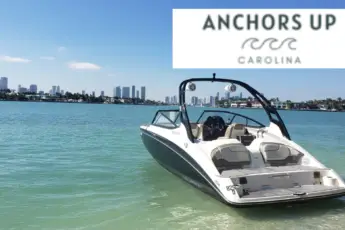Whether you’re operating a boat in a river or coastal waterway, currents are a factor. Unfortunately, currents put boat operators in a bad position because they improperly manage navigation. As an experienced captain, I have faced the challenge of driving boats in fast tidal currents and stiff winds. Without question, blood pressure rises, especially in confined spaces. Here is what you need to know about docking in strong water current.
Docking: Never Dock With The Current On Your Stern
I believe that the biggest mental laps faced by boaters is docking with the current at the stern.
The best way to maintain control of a boat in a docking situation is to keep the bow moving into the current.
Importantly, the most notable issue with approaching the dock with the current at the stern is stopping the vessel. Unfortunately, boats have failed to stop and struck other vessels secured on the same dock.
However, that is not all. Secondly, the ability to turn is reduced because the water flows with the boat compared to the bow.
For this reason, always steer with the bow into the current when approaching a dock. Believe it or not, if done correctly, the current will draw the boat towards the dock and allow you to rest it against it gently.
I prefer docking in a current on the bow because I feel that I have more control compared to no current at all. Furthermore, on windy days, the wind has little to no impact because of the constant forward motion with the throttles pushed forward.
Being Set Down On Stationary Objects
As a boater in the Savannah, Georgia area, I am often faced with tidal changes of up to 9 feet. Without question, that is a significant amount of water movement over a relatively short period of time. For this reason, the current flows rapidly.
Importantly, boaters are rivers often face the same type of conditions. All too often, boat operators are caught off guard.
No matter whether you’re underway or drifting, the direction of the boat becomes influenced by strong water current.
If you’re drifting, watch for channel markers or other floating objects. You’re likely to come up on them on short notice if you’re not on the lookout.
The current impacts boats in motion often in unexpected ways. I have witnessed boaters strike bridge pilings because they underestimate how the vessel would be pulled port or starboard. Power the boat up as needed to maintain a straight heading.
Crowding Boats Headed Down Current
If you’re operating in a narrow waterway, understand that the vessel heading down current has less control than the boat heading up current.
In the Intercoastal Waterway, it is common courtesy to let the down-current boat pass through a bridge before the up-current boat. The down-current captain can hold a boat steady while the downcurrent boat is constantly being pushed towards the bridge.
Additionally, in a narrow waterway give plenty of space to the boat heading down current. Again, the up-current boat has more control while the down-current boat is at the mercy of the water pushing them from the stern.
Failing To Apply Enough Power When Headed Up Current
Without a doubt, the throttle is your friend when heading into the current. The boat will remain on a straight course when enough power is applied.
However, I am not referring to pushing the throttle to the pins. In controlled wake zones, only enough power can be applied to keep the boat on course.
I have been surprised at times by how much I had to power up just to keep my boat on track. The same has applied to me for both sportfishing boats in addition to small center consoles.
Improperly Reading The Direction Of The Current
In a freshwater river, the direction of the water flow is apparent, especially because it moves in one direction at all times.
Conversely, in coastal waters, the water will flow out in the same location as it will flow in, depending on the tidal phase.
One of the best resources to determine the direction of flow is to read a tide chart. The tide chart will provide valuable information, such as the timing of the high and the low tides.
All too often, I have seen boaters pull out of the dock, falling to realize the current is on the stern before coming in close contact with adjacent docks down current.
For this reason, always be mindful of the direction of flow before throwing lines from the dock.
Strong Water Currents Provide Challenges To Boaters
Boater operators, without question, have a lot to think about regarding tidal flow and rivers. Being aware of the flow direction is essential to react properly if you begin to feel as though you’re getting set down. I have been set down and will admit its not always a warm and fuzzy feeling. Take your time, but power up when needed.







